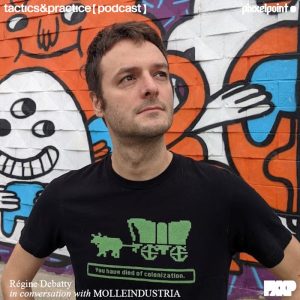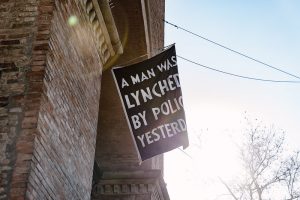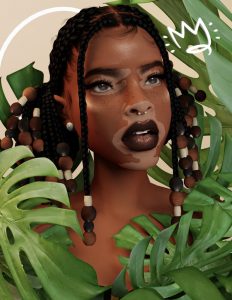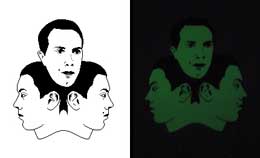 I never knew what to think about Norbert Bayer, aka Mr. Ministeck. Well, actually i thought i did: he was just an artist famous for playing with plastic bits, wasn’t he? But i changed my mind when i saw his work for the first time and read a text he had written about it in Ludic Society. Turns out that the guy is bright, his work could not be imitated as easily as i had thought and he loves Italian disco.
I never knew what to think about Norbert Bayer, aka Mr. Ministeck. Well, actually i thought i did: he was just an artist famous for playing with plastic bits, wasn’t he? But i changed my mind when i saw his work for the first time and read a text he had written about it in Ludic Society. Turns out that the guy is bright, his work could not be imitated as easily as i had thought and he loves Italian disco.
Mister Ministeck composes plastic mosaics using Ministeck, a game for children popular over the past decades. By pressing colourful pushpins onto plug-on boards to create a “pixelized” image, he translated icons from the computer world into tangible pictures. For example, the Touchscreens series is based on screenshots from C 64 games.
But there’s more to Mister Ministeck than bits of plastic pushed on a white grid.
I remember ministeck from when i was a kid. Is the company still manufacturing and selling them? are kids still playing with ministeck?
They are still producing it. After a short period back then in 1998 when Ministeck wasn’t available, they started to produce it again. It’s produced by a small company which is a family business. They are also producing kitchen gears and small plastic pieces for the car industry. I don’t know if children are still playing with it. I think maybe more adults who remember it from their childhood or the 80ies play it.
What is your relationship with the manufacturer? Are they happy that you make some kind of publicity for them? Or are they asking for royalties?
There is almost no relationship. I just order what i need and they send an invoice. I think the relationship could be better, because they get a lot of promotion through my work, if I want it or not. My work is of course always somehow connected to them and a lot of people go and buy Ministeck to do it on their own after they have seen my images. They simply can’t see no difference between my work and people who do ministeck as a hobby.
Additionally when there’s press about me – and I have worldwide press – often their url is also mentioned.
In 1999 they came in three over 300 kilometers to one of my first exhibitions and they were astonished that I use the computer to produce my patterns after which I work. 1 and 1/2 years later they threw their own computer application for transferring images into patterns on the market, which I still don’t use. But when i browse the online forums for hobbyist-ministeckers I only read about complaints, well…
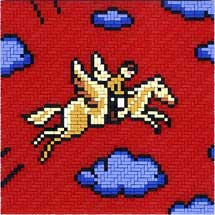
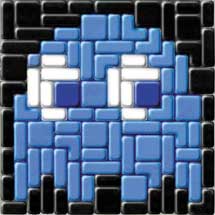 How did you come up with the idea?
How did you come up with the idea?
In the days of the goldrush of the internet-industry, while doing an internship at now dotcom-dead Pixelpark, I realized that the work I was doing now at my computer was the same I had been doing as a child whilst doing ministeck: Arranging pixels on a grid. At the computer it’s the grid of the bitmap-file which in the “real world” is represented by the grid and the plastic bricks of Ministeck. I was inspired by the musician Pinknoise who uses sounds similar to or sampled from C64 games. Then i thought why not start working with images taken from C64 games, as their colour-depth matches the palette of Ministeck.
Was it an art project right from the start or a kind of half-serious project that got more success than you had planned?
To be honest: although I believed in what I did – and still do – I didn’t expect that I would go on with it for such a long time and with such a wide range of exhibitions and a huge audience as I have. But I got a good feedback from the start and invitations to other exhibitions and one idea after the other so I just went on. And last but not least I sold a not very cheap image at the opening of the first exhibition – I still blame the bloke who bought it to bring it all on the way. ;-)
When I look back on the seven years it’s amazing and quite unbelievable how my work made its way through the different possiblities of bringing art to the public: From self organized artists’ bars in cellars to exhibitions in museums, from shows at fashion & accessories-stores to an exhibition in Jersusalem organized by the Goethe-Institut. But what’s still not in my list are official galleries who have collectors… and maybe it might never happen. But what might happen in the near future is a guest lecture at Hochschule fuer Gestaltung und Kunst in Zurich. I think this is very funny – “teaching” ministeck at an official artschool – as the whole Mister-Ministeck-Story is definitely based on do-it-yourself: From the way of producing the images to the way of marketing and distributing my artworks.
Some people are surprised how I could make my way into big exhibitions like Artgames at Ludwig Forum in Aachen, Germany and in most cases I can just answer them: Well, I received an invitation via e-mail. For me this is also the proof that the people who invited me have chosen me because they think my art is interesting – and not in first row because I’m friends with them or went out partying with them the whole night through – not that that wasn’t possible. ;-)
But of course I have to say also thank you for the little big help from my friends and supporters who made this all possible and
encouraged me with their knowledge and passion – you know who you are! So it’s not only about do-it-yourself, it’s also about connecting your friends and pushing it to the limit.
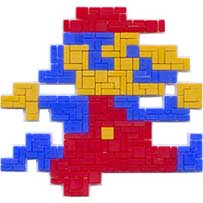
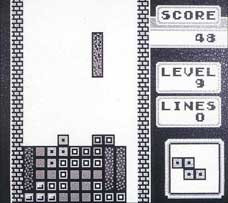 When i first saw your work on a website and was very dubious, kind of “i can make that too.” Then i saw your pieces in Aachen and i changed my mind. i understood that 1. you had the idea first 2. your work has a charm i could never be able to replicate.
When i first saw your work on a website and was very dubious, kind of “i can make that too.” Then i saw your pieces in Aachen and i changed my mind. i understood that 1. you had the idea first 2. your work has a charm i could never be able to replicate.
Of course on my website the stuff has a different appeal, because on one hand it is not the material which you see and which can be touched, but an image of it. And the haptic sensation is a major factor of my work, because it is based on the main concept of transferring analogue images to objects in the real world. On the other hand I have mainly small images on my website because when I put big images there you can’t see the material anymore anyway, because the roughness of the bricks gets lost while bringing a big image back on a small computer screen. But I like the concept of looping or better re-introducing the images to the digital sphere when I bring back a ministeck-image of a computer screen on a monitor.
What makes your work different from possible imitations?
One aspect of my work surely is that it’s kind of “open source”: at first glance everybody can go and buy the material and do it at home also – like Beuys said: “Everybody is an artist”, although he meant it in different context. But these aspect clears also what is the “creative act” of the artist, that it’s my choice for the images which I do and also the way I do them. For years I thought that everybody can use the technique like I do, but I found out that it’s not true. I have a special way of avoiding or producing regularity in using the different forms of the bricks which can hardly be copied.
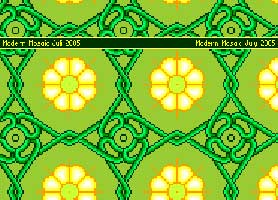
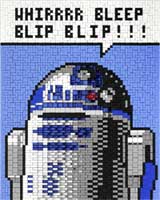 While your ministeck work make the immaterial material, the illustrations and modern mosaic go the opposite way. In which world do you feel most comfortable: the physical or the computerized one?
While your ministeck work make the immaterial material, the illustrations and modern mosaic go the opposite way. In which world do you feel most comfortable: the physical or the computerized one?
I started to work in the fields of illustrations to widen my asthetic and economic possibilities and to leave the aspect of the material itself a bit aside. I also wanted to proceed in the concept of my work and avoid being caught in the effect of ministeck. Instead I wanted to have another way of reflecting the technique I use. I feel the most comfortable in flipping from one way of working to the other, because I get bored of each one at a certain point. And I love
getting back to the other at the same time. My favourites are the mixed images for which I do images in ministeck and integrate them into an image of digitalized pixels. Unfortunatley that takes a lot of time and is a bit complicated too, because these images can hardly be resized for being printed, because the digital part must stay crispy and blocky and the scanned parts must stay smooth and photorealistic.
You live in berlin, a city where i see nostalgia everywhere: people wearing vintage clothes, there’s plenty of old-style cafés, shops selling East German appliances. Looks like the perfect place for someone who works with old-school plastic pins. What do you think that city can offer to young artists?
Berlin is a place which offers a lot of possibilites – if you just search for them. The structures of the artworld are not as firm as in
other cities i guess. A lot of things mix up here more than in other places, for example the art-scene and the music-scene.
Last weekend I exhibited at the club RIO. There was an 80’s party to celebrate the release of the dvd “Berlin Super 80’s” with old films by artists from the 80’s. They invited musicians who are inspired by the power of the vibe Berlin had in the 80’s – for example Vita Doll and also me to exhibit there.
Exhibiting at a party is a quite regular way of showing art in Berlin and I know that a lot of people are snobbish about it, because they think that art should only be displayed in white cube galleries. But I see it as a challenge and also as an advantage, because I can present my work to more people than would ever come to an opening of
an exhibition.
I’m not getting inspiration from the birds or the dogshit in the streets of berlin, but I get inspiration from the people and the relations between the different universes of the city: East – West, art-music, then – now.
Ministeck is also a fashion line, do you knit the pieces yourself?
No, I need also some time to rest. ;-) I have somebody who does it for me – although I know how to knit of course. But I heard that recently Malcom McLaren is doing the same fashion stuff I did five years ago.
I read that during an exhibition in Kassel last year, you showed a retrospective of your work: “The early years”. That’s rather ironic, you started ministecking only a few years ago!
Actually the exhibition was five years ago, quite soon after I started to work that way. But already back then I meant “The early years” ironically in terms that people in their early years – as children – play it and that that period of course were “my early years” in art, also when I started not that much time ago. It can also be seen as a bona fide trip down nostalgia lane. So many things were different back then: I lived in another town, had other people around me and different expectations and dreams.
By the way: Besides that one title I’m never ironic in my work, as irony is an effect which doesn’t last a long time. Ministeck is too much work for being just ironic. A lot of people think that one of my intentions is to be ironic. But irony is a term which is often used when people can’t find another explanation.
Do you think your ministeck art has evolved over the years? In form or in terms of content?
My work has definitely evolved in both form and content through the years. Technically I make bigger pictures than at the beginning and I make also prints on different materials now. But also the content has changed from a media-art-approach (“analogue eats digital”) to a personal psychologic aspect (“The drama of the sentitive child” and other topics) as it’s pointed out by Nadja Smeralda in her article “Permettez!”.
The text is online, but only in German until now.
My work gets simply more personal. Less copiable. More unique. Last week I did my first self-portrait. With flourescent pixels. I was being filmed while working on the image by my friend John . I hope to be able to present that documentary soon on my website.
By the way, your italian sounds excellent. Did you learn it while you were in Treviso?
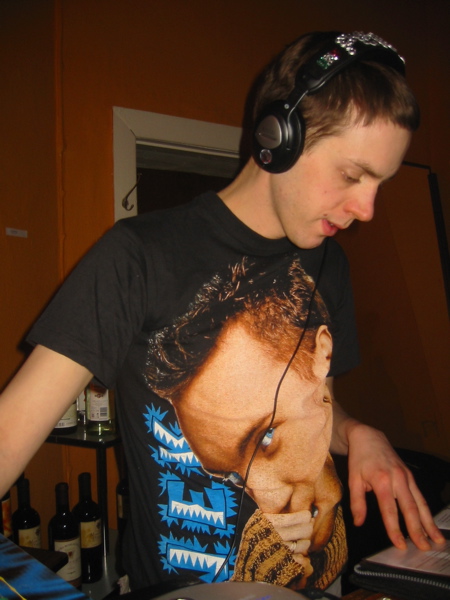
No, I learnt it in school as regular 3rd language for five years.
What were you working on at Fabrica?
I was part of the web-departement and worked on bringing the COLORS-magazine online. But is was more boring than I expected, the web department was run like an agency. Shortly before I came they had a change in their way of running Fabrica. At the start they were very open and free in their projects, but after an external teaching guy was there and spend millions for an artistic project they thought they needed to change to a more economic direction. And that kind of
institution wasn’t exactly what I wanted to work for at that time. Especially not at a far of place like Fabrica is. It’s like a monastery. You’re just there working or at home with other people from Fabrica. Which is nice for two weeks, but not for longer. On weekends you can travel to Venice or go ski-ing. That’s it.
But experiencing the temperament of Olivero Toscani in his weekly meetings with all members of Fabrica was fun. Fun when you’re one of the lucky few on whom he’s not going to empty the recycle bin of his mind on. ;-) And I met interesting people there with whom I’m still friends after all that years.
Which creatives do you look up to? Are they fine artists? Game developers?
Today I look up to everybody who has his own style and convinces the others with it and makes it work.
If i think about the past I really look up to Marcel Duchamp and Jopseph Beuys – artists who created more than just their work. Artist who didn’t care about the market or even tried to keep their art out of the market or searched for works which are neiter art nor non-art, like Marcel Duchamp.
You’ve recently completed your studies of fine art in Kassel. What was your final exam about? Ministeck or something totally different?
It was with and about ministeck of course – my professors also insisted that I do something with ministeck. But I did not only works of made of ministeck, they were only a part of it. It was about why I did ministeck at an art-school, what psychological reasons made me do it and which problems you face when you work the way I do it.
There’s the marvelous text “Permettez!” by “Nadja Smeralda” about the exhibition of my final exam, which is published on my website. You can also find some of the images there.
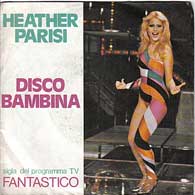
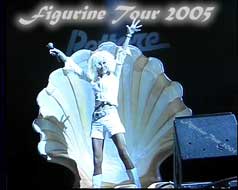 You’ve got a life out of Ministeck as well. I read that you also make illustrations for magazines and you recently told me that you like DJing Italian music from the 60s. Can you tell me why this fascination for Italian music? And names? Can you tell us the names of the singers you like playing?
You’ve got a life out of Ministeck as well. I read that you also make illustrations for magazines and you recently told me that you like DJing Italian music from the 60s. Can you tell me why this fascination for Italian music? And names? Can you tell us the names of the singers you like playing?
I just like it. Maybe also because I live in a small flat which has windows only facing north – I’m just not able to listen to depressive guitar-sounds and destructive electronic-trash. I need feel-good-music and lots of colours at my home to avoid going mad and committing suicide. Actually I’m not focused on the 60’s but also
Italian music up to the 80ties and italo disco mixed with HNG, baia sounds and synth pop. My all time favourites are Donatella Rettore, Heather Parisi and recently Loredana Berté.
What i would advise your readers to listen to is Alberto Camerini‘s “Tanz Bambolina!” and my prediction for a summer-hit is “Donna Rouge” by Fake – a Swedish Synth Pop Band.
Check my profile at myspace.
The “I simply like it” & feel-good aspect of my dj activity is also very important for me. To be honest at the moment I’m a bit stuck in my work with ministeck as the latest works were very hard for me to do, because I searched for the psychological background why I stayed with ministeck for so long and why I still do it, although I know about its limitations. So either I have to open pandora’s box even more or I just have to put a bunch of italo-sounds on it. But when I work about my own demons I try to communicate with the public in an entertaining way. I don’t like to bore people.
The fun of my ministeck-activity has a bit gone lost for me at the moment, but unfortunately it wasn’t replaced by a business aspect at the same time.
BTW: I’m looking for a new (part time) job right now and I’m also willing to relocate. I’m open to any offers, could be of course also outside Germany.
My work as artist and dj is also about the marketing structure developed by capitalism. When I go somewhere and buy the creepiest vinyls for one Euro in a bunch as big as I can carry, I can be sure that one week later it’s going to be on top of the shelf for 5 or 10 Euros again. Can you see the similarity between this and my ministeck-story?
Somehow these two interests – at first glance – seem to have nothing in common. But I think there is, I don’t know if it’s just paranoia or whatever, but maybe there is more than my private connection to both phenomenoms.
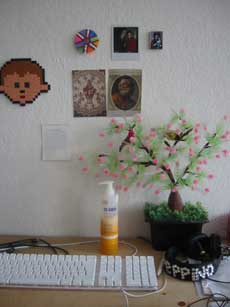
The Dutch are in general a lot into italo disco, for example the main 20th anniversary ITALO-DISCO party which is going to take place at 6th of May in Italy (if any if any of you is going to join me – please e-mail!) is organized by Dutch people. And for reasons I don’t know ministeck as material for hobby art is even more common than in Germany and also my artwork is very often featured in the Netherlands. For example I did a big feature with illustrations of 80’s stars for the magazine sQueeze and a Dutch filmmaker wants to produce a documentary about my way of working. The Dutch just seem to have the right mentality to appreciate the work I do and seem to like the same stuff. Maybe the things I like seem are going together better than assumed, although the one thing is very meditative and low and the other very energetic and high. But both are quite childish, teenage & soft…
What’s on Mister Ministek desktop?
From top left: image made of pärlplatten, the Nordic version of Ministeck, I got it from a child who visited one of my exhibitions – me and Vita Doll – Russian icon – Mister Ministeck logo designed by Tralala Bluemerant – floor mosaic from the dome in Cologne – mosaic from the church St. Peter and Paul, Berlin Wannsee – mini biography of Vincent van Gogh – Reamin, professional protective care for the
hands – of course I work on Apple – plastic tree with singing birds from Napoli, a present by Suzana Sucic – Peppino’s headphones, a present by Charlie Le Mindu.
Danke, bedankt, grazie mille, Norbert.



